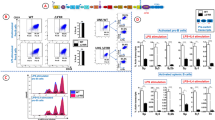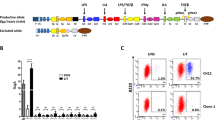Abstract
Experiments show that class switch recombination (CSR) depends on the number of divisions that the cell has performed rather than on the time since stimulation. Using computer simulations of CSR dynamics in B cell populations, we addressed the following questions. How does the probability of CSR depend on the number of divisions that a cell has performed? How does the cell decide which isotype to switch to? Does this decision depend on the distance between the genes of the pre-switch and the post-switch isotype? Our results indicate that post-switch isotype choice may be determined indirectly by the probabilities of division (which is fixed) and of switching per division (which increases as a function of the number of divisions that a cell performs), and more directly by a bias in the choice of the post-switch C gene segment towards those proximal to the pre-switch C gene.
Similar content being viewed by others
Abbreviations
- CSR:
-
class switch recombination
- AID:
-
activation-induced cytidine deaminase
References
Armitage, R.J. et al., 1992. Molecular and biological characterization of a murine ligand for CD40. Nature 357, 80–82.
Avery, D.T., Kalled, S.L., Ellyard, J.I., Ambrose, C., Bixler, S.A., Thien, M., Brink, R., Mackay, F., Hodgkin, P.D., Tangye, S.G., 2003. BAFF selectively enhances the survival of plasmablasts generated from human memory B cells. J. Clin. Invest. 112, 286–297.
Coffman, R.L., Lebman, D.A., Shrader, B., 1989. Transforming growth factor beta specifically enhances IgA production by lipopolysaccharide-stimulated murine B lymphocytes. J. Exp. Med. 170, 1039–1044.
Daniels, G.A., Lieber, M.R., 1995. RNA-DNA complex formation upon transcription of immunoglobulin switch region: implications for the mechanism and regulation of class switch recombination. Nucleic Acids Res. 23, 5006–5011.
Deenick, E.K., Hasbold, J., Hodgkin, P.D., 1999. Switching to IgG3, IgG2b, and IgA is division linked and independent, revealing a stochastic framework for describing differentiation. J. Immunol. 63, 4707–4714.
Durandy, A., Honjo, T., 2001. Human genetic defects in class-switch recombination (hyper-IgM syndromes). Curr. Opin. Immunol. 13, 543–548.
Ehrenstein, M.R., O’Keefe, T.L., Davies, S.L., Neuberger, M.S., 1998. Targeted gene disruption reveals a role for natural secretory IgM in the maturation of the primary immune response. Proc. Natl. Acad. Sci. USA 95, 10089–10093.
Gould, H.J., Sutton, B.J., Beavil, A.J., Beavil, R.L., McCloskey, N., Coker, H.A., Fear, D., Smurthwaite, L., 2003. The biology of IgE and the basis of allergic disease. Annu. Rev. Immunol. 21, 579–628.
Gregorek, H., Madalinski, K., Woynarowski, M., Mikolajewicz, J., Syczewska, M., Socha, J., 2000. IgG subclass distribution of hepatitis B surface antigen antibodies induced in children with chronic hepatitis B infection after interferon-alpha therapy. J. Infect. Dis. 181, 2059–5062.
Hasbold, J., Gett, A.V., Rush, J.S., Deenick, E., Avery, D., Jun, J., Hodgkin, P.D., 1999. Quantitative analysis of lymphocyte differentiation and proliferation in vitro using carboxyfluorescein diacetate succinimidyl ester. Immunol. Cell. Biol. 77, 516–522.
Hasbold, J., Lyons, A.B., Kehry, M.R., Hodgkin, P.D., 1998. Cell division number regulates IgG1 and IgE switching of B cells following stimulation by CD40 ligand and IL-4. Eur. J. Immunol. 28, 1040–1051.
Hodgkin, P.D., Lee, J.H., Lyons, A.B., 1996. B cell differentiation and isotype switching is related to division cycle number. J. Exp. Med. 184, 277–281.
Jones, S., Chen, Y.W., Isakson, P., Layton, J., Pure, E., Word, C., Krammer, P.H., Tucker, P., Vitetta, E.S., 1983. Effect of T cell-derived lymphokines containing B cell differentiation factor(s) for IgG (BCDF gamma) on gamma-specific mRNA in murine B cells. J. Immunol. 131, 3049–3051.
Kinoshita, K., Lee, C.G., Tashiro, J., Muramatsu, M., Chen, X.C., Yoshikawa, K., Honjo, T., 1999. Molecular mechanism of immunoglobulin class switch recombination. Cold. Spring. Harbor. Symp. Quant. Biol. 64, 217–226.
Kinoshita, K., Tashiro, J., Tomita, S., Lee, C.G., Honjo, T., 1998. Target specificity of immunoglobulin class switch recombination is not determined by nucleotide sequences of S regions. Immunity 9, 849–858.
Kunimoto, D.Y., Harriman, G.R., Strober, W., 1988. Regulation of IgA differentiation in CH12LX B cells by lymphokines. IL-4 induces membrane IgM-positive CH12LX cells to express membrane IgA and IL-5 induces membrane IgA-positive CH12LX cells to secrete IgA. J. Immunol. 141, 713–720.
Kuppers, R., Klein, U., Hansmann, M.L., Rajewsky, K., 1999. Cellular origin of human B-cell lymphomas. N. Engl. J. Med. 341, 1520–1529.
Liu, Y.J., Zhang, J., Lane, P.J., Chan, E.Y., MacLennan, I.C., 1991. Sites of specific B cell activation in primary and secondary responses to T cell-dependent and T cell-independent antigens. Eur. J. Immunol. 21, 2951–2962.
Maizels, N., 1999. Immunoglobulin class switch recombination: will genetics provide new clues to mechanism? Am. J. Hum. Gene. 64, 1270–1275.
Maliszewski, C.R., Grabstein, K., Fanslow, W.C., Armitage, R., Spriggs, M.K., Sato, T.A., 1993. Recombinant CD40 ligand stimulation of murine B cell growth and differentiation: cooperative effects of cytokines. Eur. J. Immunol. 23, 1044–1049.
McCall, M.N., Hodgkin, P.D., 1999. Switch recombination and germ-line transcription are division-regulated events in B lymphocytes. Biochim. Biophys. Acta. 1447, 43–50.
McIntyre, T.M., Kehry, M.R., Snapper, C.M., 1995. Novel in vitro model for high-rate IgA class switching. J. Immunol. 154, 3156–3161.
McIntyre, T.M., Klinman, D.R., Rothman, P., Lugo, M., Dasch, J.R., Mond, J.J., Snapper, C.M., 1993. Transforming growth factor β1 selectivity stimulates IgG2b secretion by LipoPolySaccharide murine B cells. J. Exp. Med. 177, 1031–1037.
Mehr, R., Perelson, A.S., Fridkis-Hareli, M., Globerson, A., 1997. Regulatory feedback pathways in the thymus. Immunol. Today 18, 581–585.
Mehr, R., Shahaf, G., Sah, A., Cancro, M., 2003. Asynchronous differentiation models explain bone marrow labeling kinetics and predict reflux between the pre-and immature B cell pools. Int. Immunol. 15, 301–312.
Mehr, R., Shannon, M., Litwin, S., 1999. Biased receptor editing in B cells implications for allelic exclusion. J. Immunol. 163, 1793–1798.
Moon, H.B., Severinson, E., Heusser, C., Johansson, S.G., Moller, G., Persson, U., 1989. Regulation of IgG1 and IgE synthesis by interleukin 4 in mouse B cells. Scand. J. Immunol. 30, 355–361.
Muramatsu, M., Kinoshita, K., Fagarasan, S., Yamada, S., Shinkai, Y., Honjo, T., 2000. Class switch recombination and hypermutation require activation-induced cytidine deaminase (AID), a potential RNA editing enzyme. Cell 102, 553–563.
Mussmann, R., Courtet, M., Schwager, J., Du Pasquier, L., 1997. Microsites for immunoglobulin-switch recombination breakpoints from Xenopus to mammals. Eur. J. Immunol. 27, 2610–2619.
Nagaoka, H., Muramatsu, M., Yamamura, N., Kinoshita, K., Honjo, T., 2002. Activation-induced deaminase (AID)-directed hypermutation in the immunoglobulin Smu region: implication of AID involvement in a common step of class switch recombination and somatic hypermutation. J. Exp. Med. 195, 529–534.
Pecanha, L.M., Yamaguchi, H., Lees, A., Noelle, R.J., Mond, J.J., Snapper, C.M., 1993. Dextran-conjugated anti-IgD antibodies inhibit T cell-mediated IgE production but augment the synthesis of IgM and IgG. J. Immunol. 150, 2160–2168.
Petersen-Mahrt, S.K., Harris, R.S., Neuberger, M.S., 2002. AID mutates E. coli suggesting a DNA deamination mechanism for antibody diversification. Nature 418, 99–103.
Phan, T.G., Amesbury, M., Gardam, S., Crosbie, J., Hasbold, J., Hodgkin, P.D., Basten, A., Brink, R., 2003. B cell receptor-independent stimuli trigger immunoglobulin (Ig) class switch recombination and production of IgG autoantibodies by anergic self-reactive B cells. J. Exp. Med. 197, 845–860.
Reaban, M.E., Griffin, J.A., 1990. Induction of RNA-stabilized DNA conformers by transcription of an immunoglobulin switch region. Nature 348, 342–344.
Revy, P. et al., 2000. Activation induced cytidine deaminase (AID) deficiency causes the autosomal recessive form of the hyper IgM syndrome (HIGM2). Cell 102, 565–575.
Rush, J.S., Hasbold, J., Hodgkin, P.D., 2002. Cross-linking surface Ig delays CD40 ligand-and IL-4-induced B cell Ig class switching and reveals evidence for independent regulation of B cell proliferation and differentiation. J. Immunol. 168, 2676–2682.
Rush, J.S., Hodgkin, P.D., 2001. B cells activated via CD40 and IL-4 undergo a division burst but require continued stimulation to maintain division, survival and differentiation. Eur. J. Immunol. 4, 1150–1159.
Shannon, M., Mehr, R., 1999. Reconciling repertoire shift with affinity maturation: the role of deleterious mutations. J. Immunol. 162, 3950–3956.
Shimoda, M., Nakamura, T., Takahashi, Y., Asanuma, H., Tamura, S., Kurata, T., Mizuochi, T., Azuma, N., Kanno, C., Takemori, T., 2001. Isotype-specific selection of high affinity memory B cells in nasal-associated lymphoid tissue. J. Exp. Med. 194, 1597–1607.
Snapper, C.M., Finkelman, F.D., Paul, W.E., 1988a. Differential regulation of IgG1 and IgE synthesis by interleukin 4. J. Exp. Med. 167, 183–196.
Snapper, C.M., Finkelman, F.D., Paul, W.E., 1988b. Regulation of IgG1 and IgE production by interleukin 4. Immunol. Rev. 102, 51–75.
Snapper, C.M., Kehry, M.R., Castle, B.E., Mond, J.J., 1995. Multivalent, but not divalent, antigen receptor crosslinkers synergize with CD40 ligand for induction of Ig synthesis and class switching in normal murine B cells. A redefinition of the TI-2 vs T cell-dependent antigen dichotomy. J. Immunol. 154, 1177–1187.
Snapper, C.M., Marcu, K.B., Zelazowski, P., 1997. The immunoglobulin class switch: beyond ‘accessibility’. Immunity 6, 217–223.
Snapper, C.M., McIntyre, T.M., Mandler, R., Pecanha, L.M., Finkelman, F.D., Lees, A., Mond, J.J., 1992. Induction of IgG3 secretion by Interferon γ: a model for T cell-independent class switching in response to T cell-independent type 2 antigens. J. Exp. Med. 175, 1367–1371.
Snapper, C.M., Mond, J.J., 1993. Towards a comprehensive view of immunoglobulin class switching. Immunol. Today 14, 15–17.
Snapper, C.M., Paul, W.E., 1987. IFN-γ and B cell stimulatory factor-1 reciprocally regulate Ig isotype production. Science 236, 944–947.
Snapper, C.M., Pecanha, L.M., Levine, A.D., Mond, J.J., 1991. IgE class Switching is critically dependent upon the nature of the B cell activator, in addition to the presence of IL-4. J. Immunol. 147, 1163–1170.
Snapper, C.M., Peschel, C., Paul, W.E., 1988c. IFN-α stimulates IgG2a secretion by murine B cells stimulated with bacterial Lipopolysaccharide. J. Immunol. 140, 2121–2127.
Sonoda, E., Matsumoto, R., Hitoshi, Y., Ishii, T., Sugimoto, M., Araki, S., Tominaga, A., Yamaguchi, N., Takatsu, K., 1989. Transforming growth factor beta induces IgA production and acts additively with interleukin 5 for IgA production. J. Exp. Med. 170, 1415–1420.
Stavnezer, J., 1996. Immunoglobulin class switch. Curr. Opin. Immunol. 8, 199–205.
Stavnezer, J., 2000. Molecular processes that regulate class switching. Curr. Top. Microbiol. Immunol. 245, 127–168.
Stavnezer, J., Radcliffe, G., Lin, Y.C., Nietupski, J., Berggren, L., Sitia, R., Severinson, E., 1988. Immunoglobulin heavy-chain switching may be directed by prior induction of transcripts from constant-region genes. Proc. Natl. Acad. Sci. 85, 7704–7708.
Tangye, S.G., Avery, D.T., Deenick, E.K., Hodgkin, P.D., 2003a. Intrinsic differences in the proliferation of naïve and memory B cells as a mechanism for enhanced secondary immune responses. J. Immunol. 170, 686–694.
Tangye, S.G., Avery, D.T., Hodgkin, P.D., 2003b. A division-linked mechanism for the rapid generation of Ig-secreting cells from human memory B cells. J. Immunol. 170, 261–269.
Tangye, S.G., Ferguson, A., Avery, D.T., Ma, C.S., Hodgkin, P.D., 2002. Isotype switching by human B cells is division-associated and regulated by cytokines. J. Immunol. 169, 4298–4306.
White, H., Gray, D., 2000. Analysis of immunoglobulin (Ig) isotype diversity and IgM/D memory in the response to phenyl-oxazolone. J. Exp. Med. 191, 2209–2220.
Wrammert, J., Kallberg, E., Agace, W.W., Leanderson, T., 2002. Ly6C expression differentiates plasma cells from other B cell subsets in mice. Eur. J. Immunol. 32, 97–103.
Xu, L., Rothman, P., 1994. IFN-gamma represses epsilon germline transcription and subsequently down-regulates switch recombination to epsilon. Int. Immunol. 6, 515–521.
Yuan, D., Dang, T., Bibi, R., 2001. Inappropriate expression of IgD from a transgene inhibits the function of antigen-specific memory B cells. Cell Immunol. 211, 61–70.
Zelazowski, P., Collins, J.T., Dunnick, W., Snapper, C.M., 1995. Antigen receptor cross-linking differentially regulates germ-line CH ribonucleic acid expression in murine B cells. J. Immunol 154, 1223–1231.
Zhang, K., 2000. Immunoglobulin class switch recombination machinery: progress and challenges. Clin. Immunol. 95, 1–8.
Author information
Authors and Affiliations
Corresponding author
Rights and permissions
About this article
Cite this article
Yaish, B., Mehr, R. Models for the dynamics and order of immunoglobulin isotype switching. Bull. Math. Biol. 67, 15–32 (2005). https://doi.org/10.1016/j.bulm.2004.05.007
Received:
Accepted:
Issue Date:
DOI: https://doi.org/10.1016/j.bulm.2004.05.007




